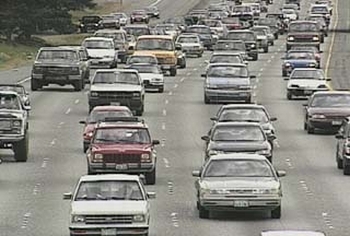OTREC Research Shows Business, Environmental Impacts of Congestion

Every day, trucks travel in, out and through Portland delivering the goods that make the city and region’s economy thrive. But urban freight traffic in the Portland metro area has become increasingly congested and unreliable, leading to longer travel times, fewer goods being distributed and more greenhouse gases being emitted. OTREC researchers have worked with commercial vehicle GPS data and freeway traffic sensor data to understand the impact of urban congestion on commercial vehicle fleets and what can be done to reduce congestion.
In “Algorithms to Quantify the Impacts of Congestion on Time-Dependent Real-World Urban Freight Distribution Networks” (Read Paper Here) and “The Impacts of Congestion on Time-definitive Urban Freight Distribution Networks CO2 Emission Levels” (Read Paper Here), OTREC researcher Miguel Figliozzi and his team attempted to quantify and measure the impacts of congestion on freight from a business, as well as environmental perspective. The project team combined time-dependent algorithms, real-world traffic data, and open source software Google Maps to analyze how congestion can delay freight traffic.
The results showed the dramatic effect congestion can have on fleet size, distances traveled by fleets and business costs. The combined use of time-dependent algorithms, real-world traffic data, and open source software Google Maps provide a more accurate methodology to measure congestion impacts than was previously available.
“The cost of congestion to society in terms of time and emissions can be as significant as the money employed to repair and improve roads,” said Figliozzi. “There are operational improvements or capital projects that can be utilized to improve congested corridors, but it’s important for (Departments of Transportation) to prioritize among competing alternatives. There are numerous ways we can budget (for transportation) projects all over the state and the region. Having accurate measurements of congestion and its associated costs is important or else you can’t do this in a fair manner.”
The amount of CO2 emissions released by fleet vehicles can also increase significantly with congestion, said Figliozzi. While the diesel engine trucks used in freight fleets can make up less than 15 percent of all vehicles on the road, they can account for over 90 percent of certain type of unhealthy emissions such as particulate matter (PM) and nitrogen oxides (NOx) . Public agencies must carefully study policies to reduce emissions because Figliozzi’s research found that the impact of congestion solutions, like certain speed limits, on emissions are difficult to predict.
“There are many variables when it comes to reducing commercial vehicle emissions and its not something that is studied holistically,” said Figliozzi. “You can reduce emissions from a land use perspective by reducing VMT or by the type of fuel you’re using, but there is no specific rule you can implement across the board or over an undefined period of time to reduce emissions without creating unwanted side effects. Governments must continuously work with shippers and freight groups to monitor progress and to determine the best available way forward.”
Through the use of more realistic and advanced methodologies to estimate the impacts of congestion on delays and emissions, Figliozzi said, governments and businesses may find better solutions to the problem of commercial vehicle congestion.
